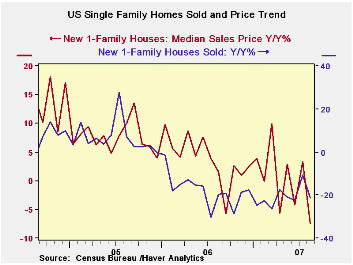 Global| Sep 27 2007
Global| Sep 27 2007US Homes Sales Still Weakening...but at a Progressively Slower Pace
Summary
The growth rates in the table below tell an erratic story of trends in the U.S. housing sector. Prices finally are lower year/year but are still, on balance, higher over the past four. Sales of new homes by region have very different [...]

The growth rates in the table below tell an erratic story of trends in the U.S. housing sector. Prices finally are lower year/year but are still, on balance, higher over the past four. Sales of new homes by region have very different histories. The Northeast sees sales lower by just 5% over the past four years ended in August. It is the strongest region by far on that score. The West and Midwest are the weakest with sales off by 43% to 47%. In the South, an area that has a portion of it that has been devastated by hurricanes and flooding is off by 27%. The chart on the left shows that the year over-year declines in home sales are getting progressively smaller. That is, from mid-2006 forward the red line slopes up to the right. That is a sign that while things may be getting worse (since the whole of this portion of the line is below zero) they are not getting worse at a faster rate, but at a slower rate. Still that is not the same as improving.
Monthly data show another sharp drop but that is coming off a rise in July. In August sales rose in two regions, the Northeast and the Midwest, and fell in two others: the South and the West.
At this time it is not clear what would be good news from the sector. Stable sales, of course, would be good news. But how to you get that with the mortgage market in disarray? How do you get that with prices still falling? One odd development that could be construed as good new is sharp drop in new home prices. Yes, a sharp drop. A sharp drop that could get out in front of the trend drop in prices and stabilize them might convince buyers that it is a good time to buy. As long as new home prices are falling the lure to buy is poisoned. That is the problem right now faced by builders.
Of course house builders always have options. They have a certain profit built in to play with – until home prices fall too far. Builders can offer to add features that the potential buyer will view at retail prices but the builder can supply at cost – and so on. But at the moment with the monthly price drop down 8 percent (NSA) home prices are still quite weak and too weak to look for stability to set in. But it is also clear that while the erosion continues, at the same time it is showing some improvement as the year/year declines in sales diminish. Moreover the West is the hardest hit region and that region could get worse if the mortgage market does not get sorted out since so many homes in the West are also expensive and require jumbo mortgage financing – the part of the markets that is in the greatest disarray after subprime per se.The Midwest faces a growing erosion in its industrial base and that is having a knock on impact on housing. The South is getting past its hurricane and flood damage. The Northeast alone is on fairly solid ground already.
| New Single Family Home Sales & Prices | |||||||
|---|---|---|---|---|---|---|---|
| Momentum: Annualized Rates Of Change | Prices | ||||||
| As of: | Total | N.E | Midwest | South | West | Median | Average |
| Aug.07 | Year-to-Year percent change | ||||||
| 1Yr | -21.2% | -14.0% | -11.2% | -27.1% | -16.0% | -7.5% | -0.4% |
| Yr Ago | -19.6% | 7.5% | -22.1% | -11.1% | -39.5% | 1.6% | 7.6% |
| 2Yrs Ago | 6.8% | 23.1% | -11.4% | 14.0% | 3.8% | 10.1% | 8.4% |
| 3Yrs Ago | -2.6% | -16.7% | -14.1% | -1.3% | 8.0% | 14.5% | 3.6% |
| 4Yrs Net | -34.1% | -5.1% | -47.3% | -27.1% | -43.0% | 18.5% | 21.2% |
Robert Brusca
AuthorMore in Author Profile »Robert A. Brusca is Chief Economist of Fact and Opinion Economics, a consulting firm he founded in Manhattan. He has been an economist on Wall Street for over 25 years. He has visited central banking and large institutional clients in over 30 countries in his career as an economist. Mr. Brusca was a Divisional Research Chief at the Federal Reserve Bank of NY (Chief of the International Financial markets Division), a Fed Watcher at Irving Trust and Chief Economist at Nikko Securities International. He is widely quoted and appears in various media. Mr. Brusca holds an MA and Ph.D. in economics from Michigan State University and a BA in Economics from the University of Michigan. His research pursues his strong interests in non aligned policy economics as well as international economics. FAO Economics’ research targets investors to assist them in making better investment decisions in stocks, bonds and in a variety of international assets. The company does not manage money and has no conflicts in giving economic advice.






